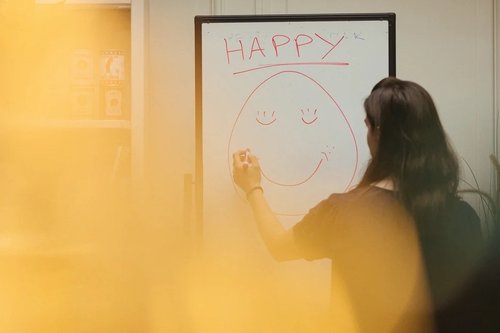9 to 5: Escaping the dream that 80s movies promised
Jun 08, 2023
8 mins


US community manager and film enthusiast
The 1960s is a collective story of youth, when a generation had a bit of childish arrogance to not only think that anything was possible, but that it was easy. But in the decades following the 60s, people started wondering if maybe they did need that 401K. By the 1980s, the generation of love had put away flower power and put on ties and suits instead. It wasn’t just a demographic shift, but a cultural and economic one, too. This was naturally reflected in the world of commercial filmmaking, which sought to reckon with these changes on screen.
In our quest to understand the broader cultural implications of Reagan-era films, we spoke with two distinguished experts. Adam Nayman is a respected film critic who writes for Cinema Scope and The Ringer, and who has penned in-depth analyses of Showgirls (1995), the Coen brothers, and Paul Thomas Anderson. We also had the pleasure of chatting with Dr. Benjamin Halligan, who oversees the Doctoral College at the University of Wolverhampton and whose writings have touched on media, popular musicology, political philosophy and activism, and film history. Together, they offer a unique perspective on the pivotal shift that marked not just 1980s cinema, but culture at large, and its implications for the world of work.
The 1970s for working America
The 1970s work environment was the last breath of Fordism. Named after the business magnate Henry Ford, the word is used to characterize our modern economic system built on the mass production of goods in factories. “The worker is almost like a machine and clocks in at nine to five on the conveyor belt merely to perform a function—whether they want to do it or not, it doesn’t matter. The Fordist idea was that this was a miserable life, but nonetheless, you were enumerated for it,” says Dr. Halligan.
Even with miserable and meaningful work, people saw real wage growth while the income gap remained stable. Women entered the workforce in mass, particularly mothers who began year-round, full-time employment. This helps explain why 15 .6 million people gain employment in the US labor market from 1972 to 1980. The occupations that grew from the increase in employment were secretaries, cashiers, registered nurses, and cooks. In other words: blue-collar employment.
In a similar strain, it was also a renaissance in American cinema for directors who were auteurs or “authors” of subversive and yet more importantly, commercial work. “I think the American cinema of the 70s has subversive tendencies because these directors were drunk on the idea that they could say something. You get directors like Scorsese, or De Palma who use the studio machinery, but their vision exceeds it,” says Nayman.
But just as auteur cinema reaches its crescendo in the 1970s, manufacturing employment and the Fordist model of work reached an all-time peak of 19.6 million in June 1979. The 1980s are about to arrive, and with that, the reality of work and film is about to shift.
Nayman says, “I think that by the time the 80s rolled around those directors still existed, but trends in the industry pushed them towards the margins. I also think that mainstream movies in the 80s were incredibly sanitized … which is in line with the sanitization of [Ronald] Reagan and the Moral Majority and all that where maybe the filmmakers who pushed against it felt even more subversive or shocking.”
‘Greed is good’ and individualism in the workplace
By the 1980s, the corporate workplace had triumphed over its Fordist counterpart, and instead of film protagonists who worked manual labor jobs in the 70s, we saw Jack Nicholson in Five Easy Pieces (1970) and Travis Bickle in Taxi Driver (1976). In the 80s, we were given Wall Street (1987).
Wall Street was originally intended to be a cautionary tale of predatory capitalism. But if you’ve ever met a guy who idolizes Jordan Belfort in The Wolf of Wall Street (2013) and tried to explain to him that this film was satire only to have it fall on deaf ears, then you won’t be surprised that Wall Street suffered a similar affliction in the public conscious. Now, both films have been widely interpreted as calls to greed.
The famous monologue in Wall Street is made by the film’s antagonist, Gordon Gekko, who says, “The point is, ladies and gentlemen, that greed, for lack of a better word, is good. Greed is right, greed works. Greed clarifies, cuts through, and captures the essence of the evolutionary spirit. Greed, in all of its forms; greed for life, for money, for love, knowledge has marked the upward surge of mankind.”
What does this end up saying about the world of work, where workers are turned into fiercely individual units, only looking to maximize their own profit in the system? It was the beginning of a form of rabid individualism that would plague American workplaces for decades to come.
Even more strangely, why was it misinterpreted so poorly? Nayman answers this question, “Who’s the most compelling character in Paradise Lost? Satan. And Michael Douglas is a very seductive Satan in that movie. Stone might be making him seductive because he sees him as the devil in a moral tale. But his protagonist is such a loser that the triumph of the Sheen character, in the end, is purely mechanical.”
The misguided interpretation of these films is not the fault of audience. It’s an old indictment of Hollywood: they can’t see the forest from the money trees. Their economic interests are often too closely aligned with corporate ones, and predictably, this creates an inaffective satire.
The 80s workplace clichés we still see today
If 1980s corporate movies have a universal sound, it’s the incessant ring of the telephone. In the blossoming age of information and communications technology, it not only depicts that the speed of work is moving faster, but it defines a key tenet of 21st-century working practices: the appearance of busyness.
Workers in the Fordist era had physical demonstrations of labor that needed to meet production quotas. Now, workers of the modern era make invisible products. Therefore, they are burdened with the expectation of constantly appearing busy, as their liberation from factories has only created a deeper insecurity to prove their worth.
When Charlie Sheen’s character in Wall Street finally meets Gordon Gekko, he appears to be the queen of a telecommunications hive, his switchboard like an intricate honeycomb. Phones were not only a status symbol tied to corporate and financial prowess but also suggested that there was an emerging attention economy, where fighting for five minutes of the boss’ time would be something you may need to compete for.
Beyond the sound of clacking keyboards and ringing telephones, the workplace in 80s films became dependent on a foreign language: work speak. An unintelligible and elite jargon built on sports metaphors, overly specialized industry terms, and the personification of numbers.
In the film The Secret of My Success (1987), Micheal J. Fox plays a mailroom employee, who finds an empty office and decides to transform himself into Carlton Whitfield, a recently hired executive. In an early conference room scene, one of his bosses, Art Thomas played by Gerry Bamman, declared, “The absolute worst has happened. We are the target of a corporate raid. Donald Davenport has filed a 13B.” What does this mean? What is a 13B? Who knows. But we can tell by inflection that it’s nothing good.
Fox then speaks up against Thomas’s solution to the corporate raid, saying that his proposal will hurt the “company’s innate value.” Thomas responds to this with the following, “Innate value? What is he talking about?”
This is work speak, and offices apparently need it to operate. Rather than focusing on language that is simple or inclusive, many workers would wrap themselves in a blanket of work speak to get ahead. Especially prevalent in research fields, it became very clear which colleagues would like to communicate, and which colleagues would like to signal their own intelligence or authority on a subject. Who suffers from cultures that trade on work speak? Anyone who is an outsider to the system: new colleagues, people without prestigious pedigrees or education, women, and POC.
It could be easy to dismiss these workplace tropes as nothing new. But the 80s gives these old ideas better shoulder pads. Nayman says, “The 80s didn’t invent it but I think the 80s mainstreamed it and made it seem not just seductive but tries to break it down like it’s an impenetrable world. And the promise of the movie is that you will penetrate it, all the buzz and all the jargon, and the hum.”
The workplace is inherently meritocratic
American films have always endorsed the meritocratic system, but 80s films enshrine this belief into the world of work. To some degree, this desire is understandable. We champion moral characters because we so desperately want to believe they succeed in real life. But this obscures the reality of corporate politics.
Nayman discusses the film Working Girl (1988), where receptionist Tess McGill (Melanie Griffith) pretends to be her Machiavellian boss, Sigourney Weaver. Griffith’s character uses this lie to get a foot in the door of the hierarchy in order to create a major business deal with an investment broker, Harrison Ford. In the end, Griffith steals Weaver’s job and her man, Ford. Do you notice the consistent theme of a righteous lie being necessary to get ahead?
Nayman discusses the film: “It’s a stupid movie. Doesn’t mean it’s a bad movie, it’s really well done and enjoyable, but that movie’s attitude towards work, it’s attitude towards class … That movie’s suggestion at the end is that everything we see about this striated, corporate hierarchy, where people are exploited and condescended to and this cruel, ruthless attitude, embodied by the Sigourney Weaver character. Actually, it’s all okay if you do the same thing, but as long as you have a heart of gold.”
It seems like even less of a truth of the world of work, as more and more evidence suggests that many factors for getting hired and advancing in the hierarchy are based on the arbitrary and subconscious preferences of those in charge. This can include recruiters perceiving candidates who wear black as more serious, as well as more official barriers to entry and advancement including race, gender, socio-economic background, etc.
Movie jobs vs. real jobs
American popular movies in the 80s were marked by some significant changes but also many superficial changes. From 1920 to 2020, there are some consistent themes: never be openly political, push black-and-white moral ideologies, and never truly depict work.
Nayman wonders whether movies have never depicting ‘real work’ because work is boring. Because work was never and can never be the most exciting or plot-driving part of our lives. He says, “So there may just be a cognitive dissonance there where we’re never going to have an escapist medium that’s truly committed to work.”
Yet there is an argument to be made that pure escapism doesn’t really exist. Even in galaxies far, far away, we ultimately find ourselves. In a film like Top Gun (1986), which on the surface is about Naval Fighter pilots, you can read it as being “about entering a specialized workplace. That’s actually a movie about office politics,” says Nayman.
These “low culture” films are the most revealing of the society that created them. They exist as collective, cultural fantasies. So while 80s films may not be documentaries committed to detailing work in a traditional sense, they were foundational in setting up real workplace expectations for a generation born in the 80s, 90s, and 2000s.
These expectations encompassed ideals of fairness, decency, and the potential for a prosperous life through dedication and hard work. These were values fought for in the 1960s that were then taken for granted in the 80s. Today, our generation finds itself navigating the afterlife of these ideals.
However, rather than viewing these movies as a eulogy, we can see them as reminders. They are urging Millennials and GenZ to revisit and redefine the world of work we have been handed. In this light, these films become more of a call to action for the future we wish to shape.
Photo: Welcome to the Jungle
Follow Welcome to the Jungle on Facebook on LinkedIn and on Instagram and subscribe to our newsletter to get our latest articles every day!

More inspiration: Our relationship with work

Advice for people pleasers: Breaking free from being “too nice” at work
Do you often say things like, "Yeah, sure, I can do that!" when in fact you don't have the bandwidth to do that? We've got you.
Dec 12, 2024

There’s no place like home: Does relocation hurt productivity?
Relocating often brings homesickness, but it’s part of the journey. Here’s how to embrace the change and make the most of it.
Oct 22, 2024

Should you take your office crush to the next level?
Is an office crush worth the risk, or more damaging to your career and reputation than you think?
Oct 09, 2024

Young workers on unpaid internships: Was it worth it?
While internships build skills and connections, unpaid ones can limit opportunities for those who can't work for free. Is it fair?
Sep 12, 2024

Sleeping less to succeed more: Do CEOs sleep as little as we think?
In today's fast-paced corporate world, a common belief is that successful leaders, particularly CEOs, need less sleep to achieve their goals.
Aug 26, 2024
The newsletter that does the job
Want to keep up with the latest articles? Twice a week you can receive stories, jobs, and tips in your inbox.

Looking for your next job?
Over 200,000 people have found a job with Welcome to the Jungle.
Explore jobs